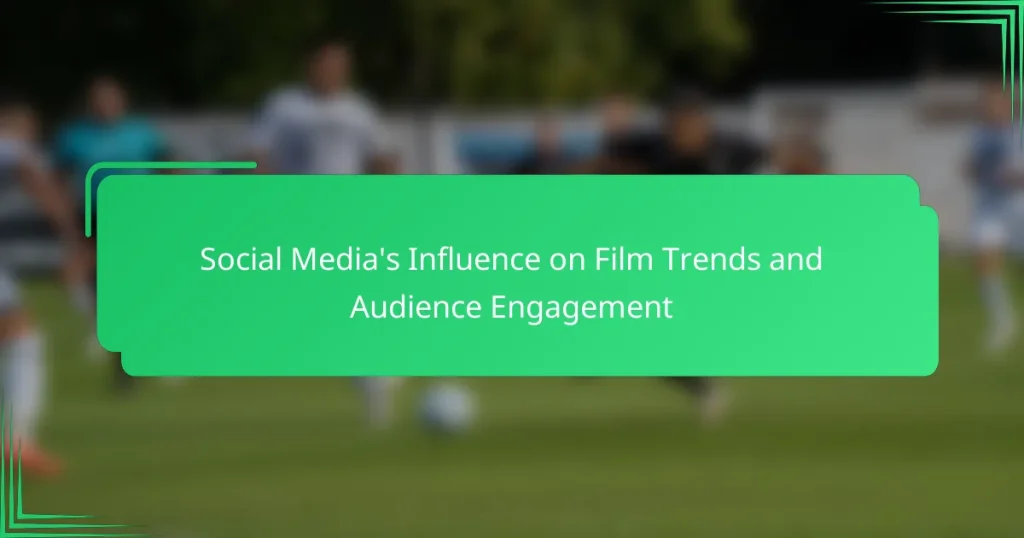Social media plays a pivotal role in shaping film trends and enhancing audience engagement by enabling rapid information sharing and real-time feedback. Platforms like Instagram, Twitter, and TikTok not only promote films but also foster community interactions, allowing audiences to connect deeply with content through discussions, sharing, and visual storytelling. This dynamic engagement can significantly influence a film’s popularity and box office performance.
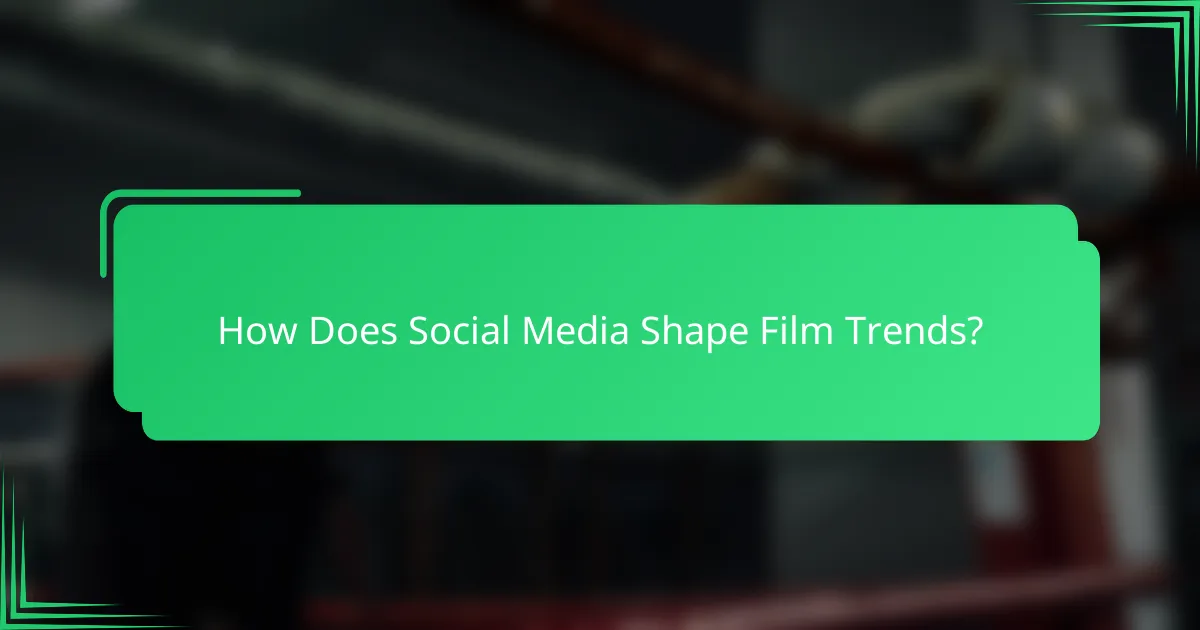
How Does Social Media Shape Film Trends?
Social media significantly influences film trends by rapidly disseminating information and shaping audience perceptions. Platforms like Instagram, Twitter, and TikTok allow for immediate feedback and engagement, which can drive a film’s popularity and box office success.
Influence of viral marketing
Viral marketing leverages social media to create buzz around a film, often through shareable content that resonates with audiences. Campaigns that go viral can lead to exponential increases in visibility, often resulting in higher ticket sales. For example, short, engaging video clips or memes can capture attention and encourage shares, amplifying the film’s reach.
To maximize the impact of viral marketing, filmmakers should focus on creating relatable and entertaining content that encourages audience participation. Engaging challenges or hashtags can further enhance the likelihood of virality.
Impact of user-generated content
User-generated content (UGC) plays a crucial role in shaping film trends by allowing fans to express their creativity and opinions. This can include fan art, reviews, or even remixes of trailers, which can foster a sense of community around a film. UGC often feels more authentic to potential viewers, as it reflects real audience reactions and interpretations.
Encouraging UGC can be as simple as hosting contests or featuring fan creations on official channels. This approach not only increases engagement but also builds a loyal fanbase that feels invested in the film’s success.
Role of influencers in film promotion
Influencers are pivotal in film promotion, as they have established trust and rapport with their followers. When influencers share their thoughts on a film, it can significantly sway audience opinions and drive ticket sales. Collaborations with influencers can include exclusive screenings or behind-the-scenes content that provides a unique perspective on the film.
To effectively utilize influencers, filmmakers should choose individuals whose audience aligns with the film’s target demographic. Authenticity is key; influencers should genuinely connect with the film to create impactful promotions that resonate with their followers.
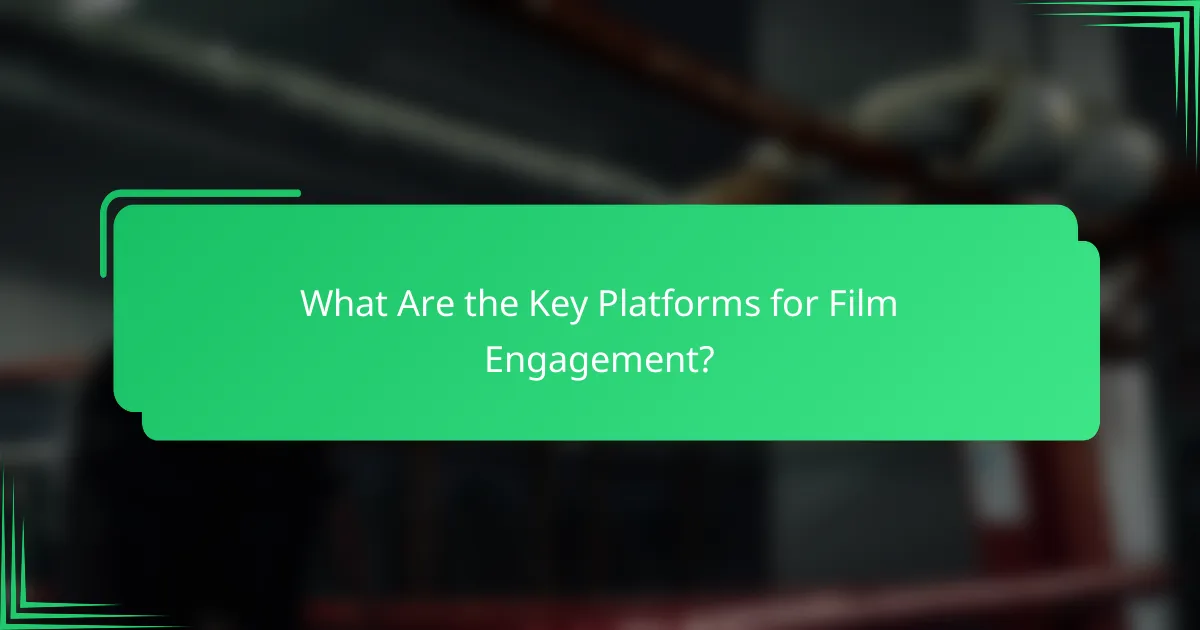
What Are the Key Platforms for Film Engagement?
Key platforms for film engagement include Instagram, Twitter, and YouTube, each offering unique ways for audiences to connect with film content. These platforms facilitate visual storytelling, real-time discussions, and access to trailers and reviews, enhancing audience interaction and engagement with films.
Instagram’s visual storytelling
Instagram excels in visual storytelling, making it a powerful tool for film promotion. Filmmakers and studios share captivating images, behind-the-scenes content, and short clips that draw viewers in and create buzz around upcoming releases.
Utilizing Instagram Stories and Reels can increase engagement significantly, as these features allow for interactive content like polls and Q&A sessions. Brands often collaborate with influencers to reach wider audiences, leveraging their follower base to enhance visibility.
Twitter’s real-time discussions
Twitter is ideal for real-time discussions about films, allowing fans to engage in conversations as events unfold. Hashtags related to film releases or events can help users find and join discussions, fostering a sense of community among viewers.
Live tweeting during film premieres or events can generate immediate reactions and insights. Engaging with fans through replies and retweets can also enhance a film’s visibility and encourage ongoing dialogue about its themes and performances.
YouTube’s trailers and reviews
YouTube serves as a primary platform for trailers and reviews, offering audiences a chance to preview films before watching. Official trailers can generate excitement and anticipation, while reviews provide critical insights that influence viewer decisions.
Content creators often produce in-depth analyses and discussions, which can attract significant viewership. Filmmakers can benefit from collaborating with popular YouTubers to reach broader audiences and tap into existing fan bases, enhancing promotional efforts.
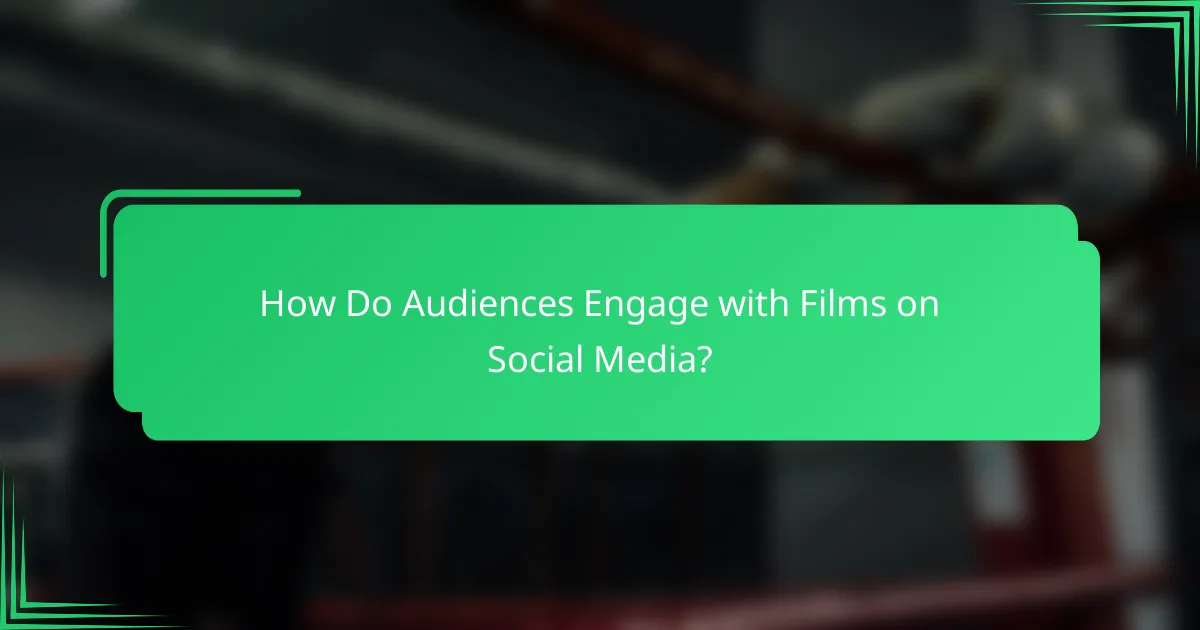
How Do Audiences Engage with Films on Social Media?
Audiences engage with films on social media through discussions, sharing content, and participating in community activities. These interactions enhance viewer experiences and create a sense of belonging among fans.
Community building around franchises
Social media platforms enable fans to form communities centered around film franchises. These communities often share fan art, theories, and news, fostering a deeper connection to the films and each other.
For example, dedicated groups on Facebook or subreddits on Reddit allow fans to discuss plot details and character developments, creating a vibrant ecosystem of engagement. This communal aspect can significantly boost a franchise’s visibility and longevity.
Fan interactions and feedback
Fans use social media to provide immediate feedback on films, influencing future projects. Directors and studios often monitor platforms like Twitter and Instagram to gauge audience reactions and adjust marketing strategies accordingly.
Engagement can take the form of polls, comments, or direct messages, allowing fans to express their opinions on everything from casting choices to storylines. This feedback loop can help filmmakers understand audience preferences and improve their offerings.
Live-tweeting events and premieres
Live-tweeting during film events and premieres creates real-time engagement among audiences. Fans share their thoughts and reactions as they watch, which can amplify excitement and draw in viewers who may not have initially planned to watch the film.
For instance, hashtags related to a film’s premiere can trend on platforms like Twitter, increasing visibility and encouraging more viewers to participate in the conversation. This immediate interaction can lead to a surge in ticket sales and streaming views shortly after the event.
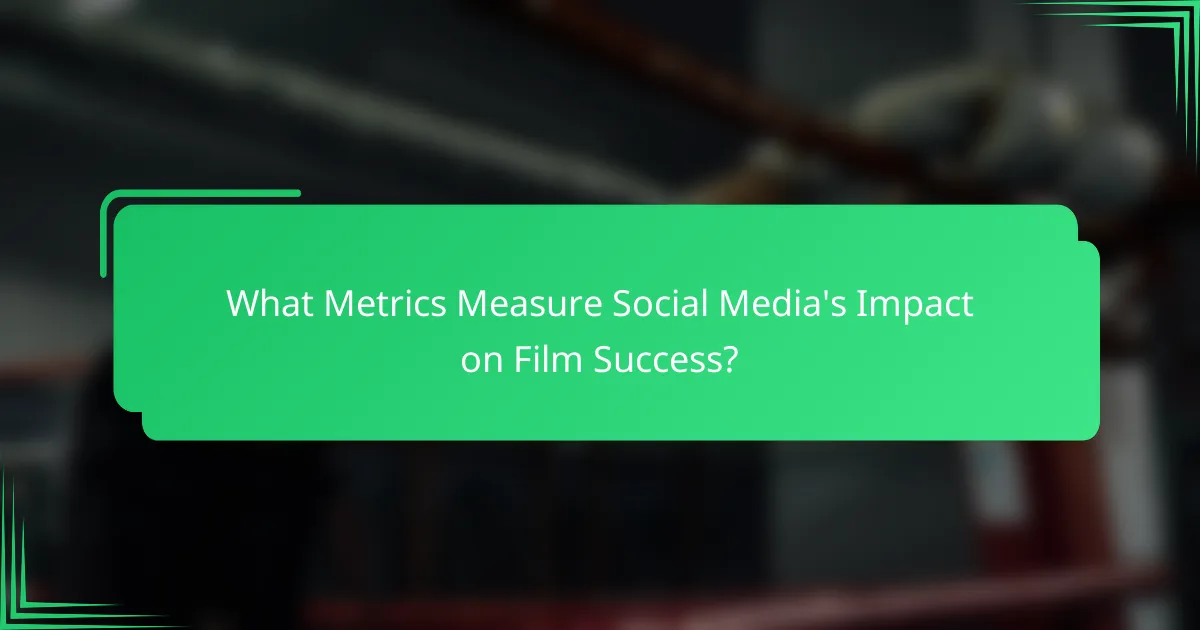
What Metrics Measure Social Media’s Impact on Film Success?
Social media’s impact on film success can be measured through various metrics that reflect audience engagement, box office performance, and overall sentiment. These metrics provide insights into how effectively films resonate with viewers and how social media campaigns influence their success.
Engagement rates and shares
Engagement rates and shares are critical indicators of how well a film’s content is received on social media platforms. High engagement rates, often measured by likes, comments, and shares, suggest that audiences are not only consuming content but actively participating in discussions around the film.
For instance, a film trailer that garners thousands of shares within a short period can indicate strong viewer interest, potentially translating to higher ticket sales. Tracking these metrics can help filmmakers and marketers adjust their strategies to maximize reach and impact.
Box office performance correlation
There is often a correlation between social media activity and box office performance. Films that generate significant buzz on platforms like Twitter and Instagram tend to perform better at the box office, especially during opening weekends. This correlation can be attributed to increased visibility and audience anticipation driven by social media campaigns.
For example, a film that trends on social media prior to its release may see box office earnings that exceed expectations, while those with minimal online presence might struggle. Monitoring social media metrics can thus provide valuable forecasts for potential box office success.
Audience sentiment analysis
Audience sentiment analysis involves evaluating the emotional tone of social media conversations surrounding a film. By analyzing comments, reviews, and posts, filmmakers can gauge public perception and identify strengths or weaknesses in their marketing strategies.
Tools that aggregate sentiment data can reveal whether audience reactions are predominantly positive, negative, or neutral. For instance, a film receiving overwhelmingly positive sentiment may benefit from targeted promotional efforts, while a film facing criticism might require a reevaluation of its marketing approach to address viewer concerns.

What Are the Challenges of Social Media in Film Marketing?
Social media presents several challenges in film marketing, including managing public perception, dealing with content saturation, and adapting to algorithm changes. These factors can significantly impact audience engagement and the overall success of a film’s promotional efforts.
Managing negative feedback
Negative feedback on social media can spread quickly, affecting a film’s reputation and box office performance. Filmmakers and marketers must monitor comments and reviews actively, addressing concerns promptly to mitigate damage. Engaging with critics constructively can sometimes turn negative sentiments into positive discussions.
For instance, a film that receives backlash for its casting choices might benefit from a direct response from the director or actors, explaining their vision and intentions. This approach can help rebuild trust and interest among potential viewers.
Content saturation and audience fatigue
With countless films vying for attention on social media, audiences can quickly become overwhelmed, leading to content fatigue. This saturation makes it essential for marketers to create unique and engaging content that stands out. Strategies such as behind-the-scenes footage, interactive polls, or exclusive interviews can help capture audience interest.
Marketers should also consider the timing and frequency of their posts. Spacing out promotional content and mixing in entertaining or informative posts can keep the audience engaged without overwhelming them.
Algorithm changes affecting visibility
Social media platforms frequently update their algorithms, which can drastically affect a film’s visibility. Marketers need to stay informed about these changes to optimize their content for maximum reach. Utilizing trending hashtags, engaging with followers, and creating shareable content are effective strategies to enhance visibility.
Additionally, investing in targeted advertising can help ensure that promotional materials reach the right audience, despite algorithm shifts. Understanding the demographics of the target audience can guide the creation of tailored ads that resonate more effectively.
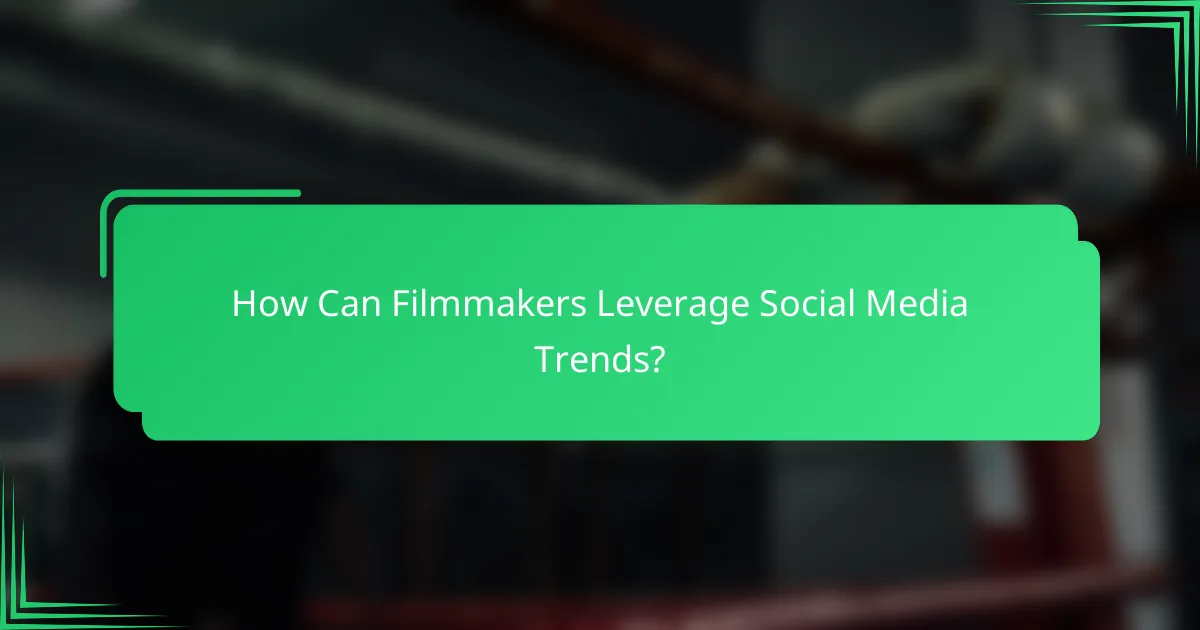
How Can Filmmakers Leverage Social Media Trends?
Filmmakers can effectively leverage social media trends by integrating them into their marketing strategies and engaging directly with audiences. This approach not only boosts visibility but also fosters a community around their films, enhancing audience connection and loyalty.
Targeted advertising strategies
Targeted advertising on social media platforms allows filmmakers to reach specific demographics based on interests, behaviors, and location. Utilizing tools like Facebook Ads or Instagram Promotions, filmmakers can create tailored campaigns that resonate with potential viewers, increasing the likelihood of ticket sales or streaming subscriptions.
Consider setting a budget that aligns with your overall marketing goals, typically ranging from a few hundred to several thousand dollars, depending on the scale of your project. Monitor engagement metrics closely to optimize your ads for better performance.
Collaborations with social media stars
Collaborating with social media influencers can significantly amplify a film’s reach. By partnering with popular content creators who align with the film’s themes or target audience, filmmakers can tap into established follower bases, generating buzz and authentic engagement.
When selecting influencers, look for those with high engagement rates rather than just large follower counts. A micro-influencer with a dedicated audience can often provide better results. Establish clear expectations and creative freedom for the collaboration to ensure the promotion feels genuine and resonates with their audience.
